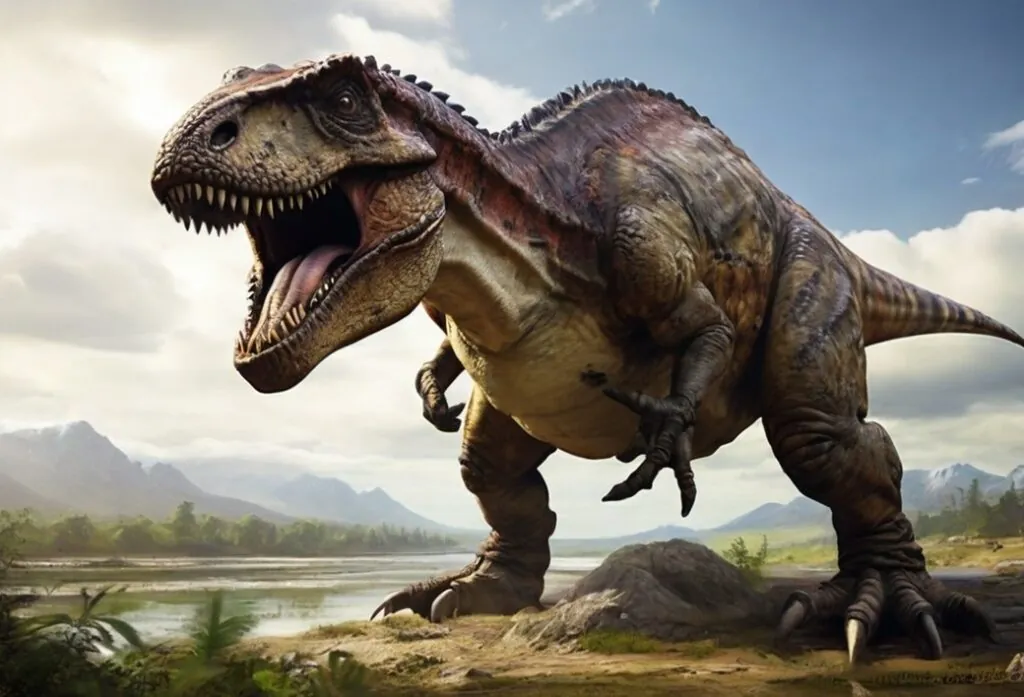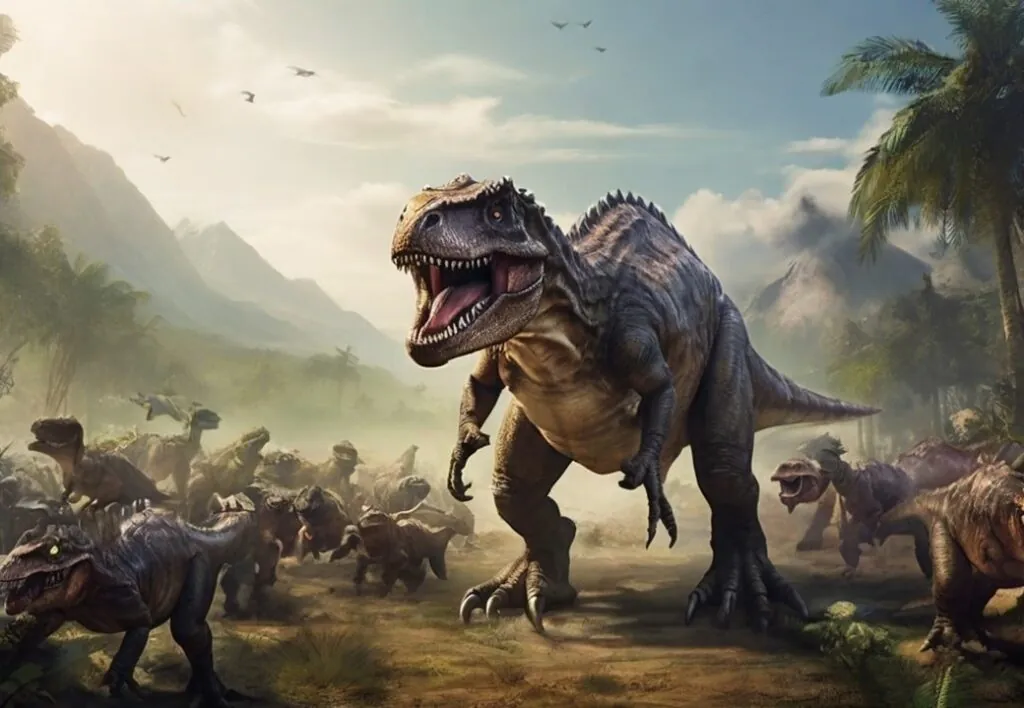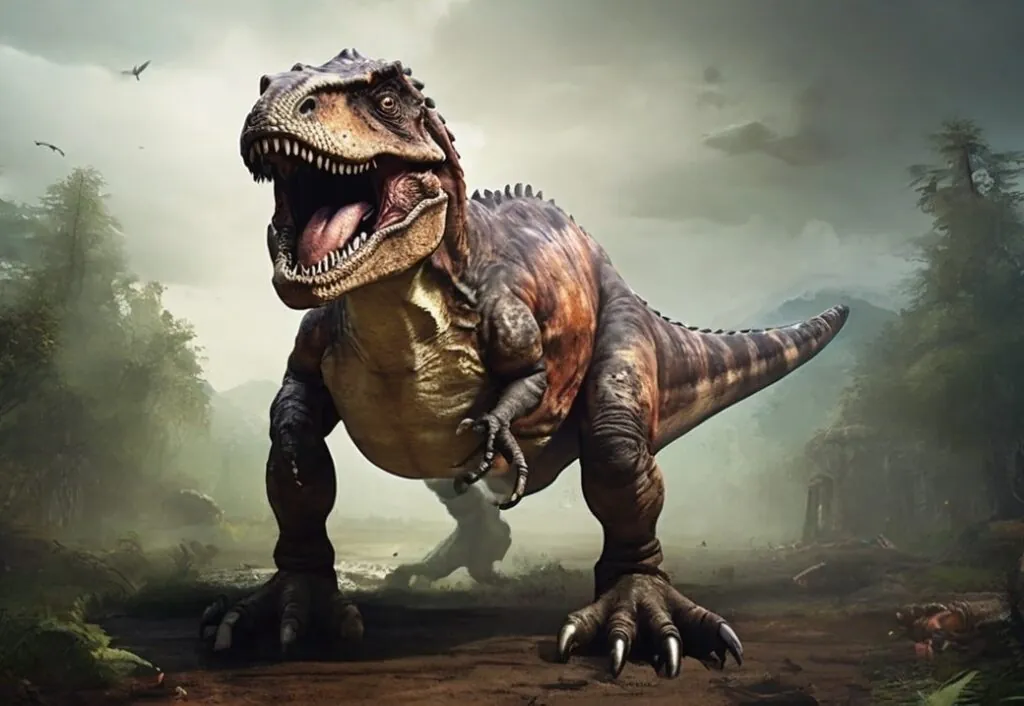Tyrannosaurus Rex: Exploring Anatomy, Diet, and the King’s Domain

T-Rex, the king of Cretaceous predators, with its full taxonomic name “Tyrannosaurus rex,” reigned 66 million years ago. Envision a creature the size of a school bus, with teeth the length of your forearm and a bite force stronger than any animal ever walked the Earth. T-rex was more than just a movie monster. How about unfolding its story full of surprising twists and turns from feathery beginning to heated debates about its hunting style.
| Kingdom | Phylum | Class | Family | Genus | Scientific Name | |
| Animalia | Chordata | Archosauria | Tyrannosauridae | Tyrannosaurus | Tyrannosaurus rex |
Origin and Evolution
Evolutionary History
In conjunction with the T-rex origin, its lineage extends back 160 million years, tracing to smaller, bipedal theropods like Dilophosaurus and Staurikosaurus. When it comes to T-rex’s evolution certain events shaped their transformation over time:
Genetic Composition and Diversity
Albeit full T-rex DNA remain elusive, studies on related Tyrannosaurids provide thrilling insights. Collagen analysis propose shared adaptations for strong bones and efficient movement. Protein traces hint at potential heat-regulating mechanisms identical to birds.
Fossil evidence unfolds some T-rex variations, including slight size differences, with Sue, the most complete T-rex specimen, weighing an approximated 8.4 tons.
Environmental Adaptations
The dinosaur roamed the western regions of North America, then an island continent named Laramidia. Its environment shaped astonishing adaptations, including the powerful legs was estimated at reaching speeds of 18 mph – a T-rex adaptation to navigate diverse landscapes.
The T-rex bite force of 12,800 pounds – generated by its massive skull and 12-inch teeth – was enough to crack even the toughest bones. Recent discoveries suggest feathers, potentially for insulation and display, in Tyrannosaurids like Yutyrannus, denoting T-rex might have had them too.
Distribution and Population
Geographic Range
With respect to the Tyrannosaurus rex’s distribution, they roamed western North America during the Late Cretaceous period, around 68 million years ago. The region – then an island continent called Laramidia – stretched from present-day Alberta, Canada to New Mexico, USA.
Population Dynamics
Owing to incomplete fossil records, estimating T-rex population size is challenging. A study conducted in 2021 suggests a global population of around 2.5 billion T-rex individuals across their entire existence.
Geography
| Continents | North America (specifically present-day Western United States and Canada) |
| Bio-geographical Realms | Nearctic |
| Biome | Western Interior Seaway (ancient shallow sea with surrounding forests and floodplains) |
| Climate Zones | Warm temperate to subtropical |
Habitat

Habitat Preferences
Speaking the T-rex habitat, fossil evidence indicates they chiefly inhabited western North America during the Late Cretaceous period – 68 to 66 million years ago. Their range spanned multiple environments, including coastal plains, floodplains and forests.
Habitat Utilization Patterns
Tyrannosaurus rex dinosaur possible followed a diurnal patter – active during the day for hunting and scavenging. It’s their large size that proposes periods of rest throughout the day to conserve energy. Tyrannosaurus rex’s hunting strategies remain debated, but they may have utilized ambush tactics using cover and keen senses.
5 Tyrannosaurus Rex Facts
Appearance

Physical Characteristics
Sexual Dimorphism
Evidence for the T-rex dinosaur’s sexual dimorphism is inconclusive and hotly debated. Some paleontologists are of the view that female T-rex were larger than males, built upon variation in leg bone size and hip structure. Other studies haven’t found prominent size differences, proposing alternative explanations for bone variations.
T-Rex Anatomy
| Tongue | Muscular and likely used for manipulating food |
| Claws | Sharp and curved, used for grasping and tearing prey |
| Mouth | Wide with powerful jaws and numerous serrated teeth |
| Jaw | Strong and capable of generating immense bite force |
| Teeth | Large, sharp, and serrated, designed for tearing flesh |
| Nose | Nostrils positioned high on the skull for improved scent detection |
| Feet | Bipedal with three toes on each foot, adapted for running |
| Skeleton | Robust and heavily built |
Reproduction and Life Cycles
Owing to the lack of fossil evidence about their soft tissues and behavior, much of T-rex’s reproduction and life cycle is a mystery. Notwithstanding the fact, based on comparisons to other theropods and egg size, the gestation period of T-rex would likely be between 2 to 4 years – this is just an educated guess.
Tyrannosaurus rex’s egg would likely be leathery, similar to other dinosaurs. On the part of hatchling, it would be small, vulnerable and dependent on parents for some time. During their adult age, the likely became apex predators at peak physical capabilities. As per estimates, the T-rex’s lifespan ranged from 20 to 30 years based on bone growth rings.
Diet and Lifestyle
Feeding Ecology
The tyrannosaurus rex’s diet varied built upon age and opportunity. Adult T-rex chiefly hunted large herbivores like Triceratops, Edmontosaurus and Ankylosaurs. This creature was the top dog in its ecosystems, implying they primarily consumed other dinosaurs.
Foraging Strategies
As per some studies, it’s suggested that they’re active hunters, employing their keen senses. Other propose they ambushed prey, resting on camouflage or exploiting terrain advantages.
Diurnal Activity Patterns
T-rex dinosaurs were likely diurnal. Their large eyes intimate good daytime vision, pivotal for hunting. Fossil data doesn’t offer definitive answers, but their active lifestyle and hunting strategies support a diurnal pattern.
As for as the tyrannosaurus rex’s behavior is concerned, their social structure is categorized as solitary. Most evidence points towards solitary lives, except maybe for mating or caring for young – if they did.
T-Rex Extinction
While the Chicxulub meteor remains a key suspect, it was not the sole villain. Volcanic eruptions in India’s Deccan Traps spewed ash and greenhouse gases. It triggered climate change and acid rain, creating a multi-pronged attack on dinosaurs. Studies suggest the impact triggered mega-tsunamis. It devastated coastal ecosystems pivotal for many dinosaurs.
Insights from Fossilized Footprints
In North Dakota, the Hell Creek Formation provides tantalizing clues. Fossilized footprints of Triceratops and Edmontosaurus herds – just months before the extinction event – propose a gradual decline rather than an instantaneous apocalypse.
Survival Strategies of Resilient Species
Small-bodied dinosaurs and early birds with adaptable diet and faster reproduction rates may have possessed the resilience to outmaneuver extinction.
Evidence of Catastrophic Wildfires
Across North America, evidence of widespread wildfires paints a harrowing picture. You can imagine dust, debris and searing heat engulfing and scorching dinosaurs.
The Enigmatic “Ghost population”
Fossil approximations propose billions of T-rex individuals, yet the actual population at dinosaurs’ extinction may have been smaller. The “ghost population” theory spotlights the complexities of reconstruction past ecosystems.
Beyond Dinosaurs
T-rex extinction wasn’t an isolated incident. It marked the culmination of the Cretaceous-Paleogene extinction. It annihilated 75% of life on Earth.
Revisiting Predatory Dynamics
In oppose to the popular belief, T-rex was not the ultimate apex predator! The semi-aquatic Spinosaurus, towering at 50 feet, reigned supreme. Both titans vanished, leaving behind enigmatic legacies.
Media and Entertainment
In the realm of art, these species have made their conspicuous presence in multiple genres:
Literature
Documentaries
Movies
The Takeaways
Forge a path through an intriguing journey as we unfold fascinating facts about tyrannosaurus rex dinosaurs – truly captivating animals that start with T. Join us in shedding light on their remarkable rundown!
| Common Name | Tyrannosaurus Rex |
| Other Name(s) | T-Rex, King of the Lizards |
| Number of Species | 1 |
| Population Size | Extinct (no living population) |
| Lifespan | Estimated 20-30 years |
| Weight | Estimated 8-9 tons |
| Length | Up to 40 feet |
| Top Speed | Estimated 40 mph in short bursts |
| Predators | Possibly large theropods or scavenging carnivores |
| Diet | Herbivorous dinosaurs like Triceratops, Edmontosaurus, Ankylosaurus |
| Most Distinctive Feature | Massive head with powerful jaws and sharp teeth |
FAQs





